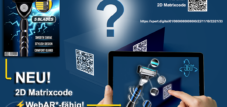
From barcode to augmented reality 3 product presentation with WebAR – Image: Xpert.Digital / gpointstudio|Shutterstock.com
Intro 3D future with augmented reality
In the age of digitalization, standardized data and efficient information exchange processes are of great importance for companies. GS1, a global non-profit organization, offers solutions for this. One of the standards provided by GS1 is the GS1 Data Link. This enables companies to store and exchange product information in a uniform format.
In order to uniquely identify products, they are provided with a Global Trade Item Number (GTIN), which enables products to be labeled consistently worldwide. The GS1 standard matrix code, such as the DataMatrix code, contains the GTIN and may contain additional information such as the batch number or the product expiry date. This information can be accessed by customers by scanning the matrix code with their smartphone.
By using GS1 Data Link in combination with matrix codes, companies can quickly and easily access product data and thus optimize business processes. The standardized storage of product information enables information to be exchanged quickly and consistently throughout the entire supply chain. This not only increases the efficiency of business processes, but also helps improve product quality and product traceability.
More about it here:
Application and use example of the matrix code for companies
A company that wants to assert itself in a modern, digitalized world needs efficient processes for storing and exchanging product data. For this purpose, GS1, a global non-profit organization, offers various standards, including the GS1 Data Link. This standard ensures that product data can be stored and exchanged in a standardized format.
The company would first bring the relevant product data, such as product descriptions, images, prices, supplier information or information about the origin of the product, into the standardized GS1 Data Link format. The data is then provided with a Global Trade Item Number (GTIN), which allows the product to be clearly identified.
In the next step, the company would print the GS1 standard matrix code, such as the DataMatrix code, on the product. The matrix code contains the GTIN number and may contain additional information such as the batch number or the product expiry date. Customers can access this information by scanning the matrix code with their smartphone.
As the product moves through the supply chain, companies can use the matrix code to access the product data. Using GS1 Data Link in conjunction with matrix codes provides a standardized and efficient way to store and exchange product information, improving the efficiency and accuracy of business processes. By storing product data uniformly, companies can also ensure that the quality of their products is guaranteed and traceability is maintained.
The use of GS1 Data Link and matrix codes an effective method for companies to store and exchange product data in a standardized and efficient manner. This enables improved efficiency and accuracy of business processes as well as increased product quality and traceability.
Using matrix codes on products offers numerous benefits and applications for potential customers
One of the most important benefits is the ability to see things and details that were previously invisible due to the packaging, outer box or other obstructions.
By scanning the matrix code with a smartphone, consumers can receive detailed product information such as origin, nutritional information or usage instructions. This not only improves the shopping experience but also helps in making informed decisions and increasing trust in the brand.
Another advantage is the authentication of products. Manufacturers can use the Matrix Code and GS1 Data Link to authenticate their products and ensure consumers are purchasing a genuine product. This also supports the fight against product counterfeiting.
Matrix codes can also be used for marketing purposes. Using WebAR, manufacturers can display digital content such as 3D models or animations directly on the consumer's smartphone or tablet screen. This creates an interactive and engaging brand experience and can increase sales.
Another important area of application is the traceability of products in the supply chain. Consumers can scan the code to verify the origin and quality of the product. This improves transparency and trust in the brand.
Finally, by scanning the matrix code, consumers can also receive information about the sustainability of products and their production. Information such as recyclability or the use of sustainable materials can help consumers make more conscious purchasing decisions and contribute to sustainability.
Overall, matrix codes offer numerous benefits and applications for potential customers, from improving the shopping experience to supporting sustainability and authentication.
How augmented reality with WebAR and the new matrix code will change stationary retail
WebAR (Web-based Augmented Reality) is a technology that makes it possible to experience augmented reality experiences directly in the web browser without the need to install a separate app. Matrix code, also known as QR code, is a type of 2D barcode commonly used to link digital content to the physical world.
In combination, WebAR and matrix codes can change brick-and-mortar retail in various ways. Some examples are:
Interactive shopping experiences
3D representation of furniture with the WebAR/Augmented Reality and matrix code recommended by Xpert – Image: Xpert.Digital / Gorodenkoff|Shutterstock.com
A retailer could place matrix codes on product packaging that customers can scan to open an augmented reality experience on their smartphone. For example, a customer could scan a QR code to experience a virtual try-on of clothing or see a 3D rendering of a piece of furniture before purchasing it.
marketing and advertisement
Companies could place matrix codes in their print ads that lead to a WebAR experience. For example, a QR code on an ad for a new cosmetics brand could direct a customer to a website where they can try out different makeup looks using augmented reality.
More information, details and 3D views – From brochures and catalogs to 3D product presentations – Image: Xpert.Digital / BeeBright|Shutterstock.com
Better customer loyalty – try out new augmented reality marketing concepts
Retailers could use matrix codes to guide customers through a virtual scavenger hunt in their store, where they can experience different AR experiences and earn rewards.
Purchasing experiences as a “adventure” - try something new: Test new augmented reality marketing concepts - Image: Xpert.digital / Zapp2Photo | Shutterstock.com
More efficient shopping experiences
Retailers could place matrix codes on products that customers can scan to get more information, such as product reviews, size charts and availability.
Smartphone business concept for stationary retail: 3D shopping experience with lots of details – Image: Xpert.Digital / panuwat phimpha|Shutterstock.com
Many more options - test and try out, it's just the beginning!
WebAR and matrix codes offer a far greater variety of opportunities to improve and personalize the brick-and-mortar shopping experience, which can lead to a better customer experience and higher sales.
Consulting, planning and implementation of 2D matrix codes with integrated augmented reality and WebAR
Xpert.Plus is a project from Xpert.Digital. We have many years of experience in supporting and advising on (Extended) Augmented Reality and in warehouse optimization , which we bundle in a large network under Xpert.Plus .
I would be happy to serve as your personal advisor.
You can contact me by filling out the contact form below or simply call me on +49 89 89 674 804 (Munich) .
I'm looking forward to our joint project.
Xpert.Digital – Konrad Wolfenstein
Xpert.Digital is a hub for industry with a focus on digitalization, mechanical engineering, logistics/intralogistics and photovoltaics.
With our 360° business development solution, we support well-known companies from new business to after sales.
Market intelligence, smarketing, marketing automation, content development, PR, mail campaigns, personalized social media and lead nurturing are part of our digital tools.
You can find out more at: www.xpert.digital – www.xpert.solar – www.xpert.plus

